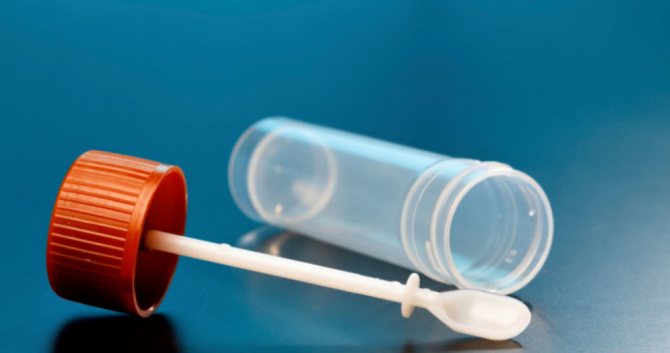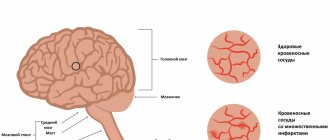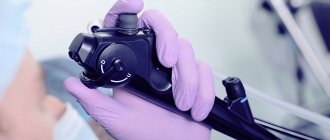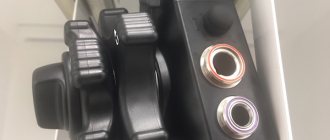Home » Stool blood test
A fecal occult blood test is a laboratory test that detects hidden bleeding of the internal organs of the gastrointestinal tract. During diagnosis, changes in erythrocyte hemoglobin are detected even in cases where determination by microscopic examination of stool is impossible. The analysis is carried out to determine hemoglobin and transferrin in the stool. Internal bleeding of any etiology and profuseness is detected.
Occult blood is blood that does not change the color or structure of stool. The presence of bloody impurities is determined only by microscopic examination. What are hemoglobin and transferrin?
- Hemoglobin is an unstable compound that is destroyed when passing through the intestines, especially with heavy bleeding. If internal bleeding is observed in the upper intestines, the test results may be false negative.
- Transferrin is a protein found in the blood. The component enters the intestinal lumen only when pathology develops and internal bleeding occurs. Transferrin is considered a more stable compound compared to hemoglobin. Allows you to accurately detect the presence of bleeding in the upper gastrointestinal tract.
There are no cross-reactions with hemoglobin and transferrin of animal origin during laboratory diagnostics. That is why there is no need to exclude meat from the diet before taking the test.
A fecal occult blood test is considered an important laboratory test that quickly detects internal bleeding in any part of the gastrointestinal tract. Bleeding refers to symptoms that indicate an inflammatory process, including oncology, and the appearance of malignant neoplasms. If internal bleeding exists even on a long-term basis, it is impossible to determine the presence of bloody impurities in the stool without a microscopic examination. Visual inspection of stool will not bring any results.
In some cases, blood can still be found in the stool. We are talking about heavy bleeding of the intestines. In this case, diagnosis is carried out visually. If bleeding occurs in the lower intestines, such as the colon or rectum, the blood turns a bright scarlet color. Clots and mucous impurities appear. If the source of bleeding becomes the upper sections, namely the esophagus, stomach, part of the small intestine, then the stool becomes black. Blood and certain enzymes produced in the intestines interact to affect the color of stool.
If internal bleeding appears even visually, then we are talking about an acute stage of the disease. Emergency measures and emergency care in a hospital setting will be required. When violations of the integrity of the mucous membrane are not so pronounced, a small number of vessels are involved in the process. At the same time, the color and consistency of stool do not change. Determination of red blood cells in feces is carried out only by microscopic examination.
If microscopic diagnostics do not reveal red blood cells, but there is a suspicion of hidden bleeding, a stool test for occult blood is mandatory. The study measures the amount of changed hemoglobin, not red blood cells.
Unqualified doctors or patients call the occult blood test the Gregersen test. The Gregersen test is a benzidine test that detects occult blood in urine, vomit and feces. Has nothing to do with the analysis described above.
What is occult blood
Occult blood does not affect the color of stool and is not detected microscopically or macroscopically. According to medical data, about 2 milliliters of blood are released in the stool every day, namely 2 milligrams of hemoglobin per 1 gram of feces. Determination of occult blood will help identify proctological and gastroenterological pathologies such as:
- diverticulitis;
- intestinal tuberculosis;
- ulcerative damage to the mucous membrane;
- benign and malignant neoplasms;
- nonspecific ulcerative colitis;
- Crohn's disease;
- intestinal infection;
- necrotizing enterocolitis;
During gastrointestinal bleeding, unchanged hemoglobin or a structure in which minimal changes have occurred is formed in the stool. The intensity of hemoglobin destruction depends on the location and severity of bleeding, on the neglect of the pathology, and on the presence of complications. As is known, hemoglobin is an unstable analyte.
Stable compounds include transferrin, which detects internal bleeding in the upper intestines. Blood protein enters the intestinal lumen during advanced pathologies of the gastrointestinal tract, with significant damage to the mucous membrane.
How to collect biomaterial and in what quantity?
Before directly collecting material for analysis, you must adhere to the restrictions described above for 3 days, including diet, as well as monitoring the intake of a number of medications.
In addition, it is not recommended to collect feces if a representative of the fair sex begins her period. In this situation, you should either ensure complete isolation of the collected material from potential menstrual bleeding (which is practically impossible), or reschedule laboratory diagnostics until the end of the cycle.
Feces for occult blood are collected in the morning during the first act of defecation. To carry out the correct test, 5-10 grams of feces are enough, which is placed in a special sterile plastic container - the latter can be purchased at any modern pharmacy.
When collecting biomaterial, be sure to pay attention to its quality, since it should not mix with urine and fall on the dirty surface of the toilet.
The optimal collection option would be to defecate on a separate clean piece of paper, as well as remove the upper layers of feces using a sterile spoon and immediately transfer them to the above-designated sterile container.
After collecting stool for the Gregersen reaction, it should be delivered to the laboratory no later than two hours after the procedure , preferably under conditions of low temperature or careful isolation of the latter from external environmental factors.
Indications for use
A fecal occult blood test is mandatory for older people over the age of sixty. Age-related changes directly affect intestinal function, so age is a direct indication. Laboratory research is carried out in the differential diagnosis of anemia, when helminths are detected, to assess damage to the mucous membrane of the gastrointestinal tract.
Intestinal pathologies are diagnosed, such as polyposis, diverticulitis, ulcerative colitis, necrotizing enterocolitis at an early age. The patient's condition is assessed during the treatment of peptic ulcer, Crohn's disease, and intestinal tuberculosis.
Analysis of feces for occult blood helps to detect in time:
- primary and metastatic tumors of the gastrointestinal tract;
- ulcerative damage to the gastrointestinal mucosa;
- helminthiases with damage to the intestinal mucosa;
- infectious intestinal lesions;
This diagnostic technique is more sensitive than less specific methods, such as benzidine and guaiac tests. The amount of hemoglobin and transferrin in stool is determined by immunochromatographic method. A fecal occult blood test determines a violation of the integrity of the mucous membrane and the presence of a duodenal papilla. The degree of soft tissue damage and the effectiveness of treatment are assessed.
The procedure is prescribed for chronic constipation and diarrhea, heartburn, nausea and vomiting, and acute pain in the intestines. Indications include mushy stool, false urge to defecate, rapid weight loss or causeless obesity, and elevated body temperature.
If a benign or malignant neoplasm has been identified, instrumental and laboratory diagnostic methods are carried out regularly to monitor the patient’s condition.
How is it carried out?
To confirm the presence of hidden blood in the stool, the Weber reaction is additionally performed - a test with guaiac resin.
The research technique is quite simple. To detect occult blood, the method of benzidine oxidation with hydrogen peroxide is used. Feces are tested for the Gregersen reaction in this way: the material for analysis is smeared on a glass slide and a few drops of the reactive substance are added. In this procedure, hidden blood acts as a catalyst for the release of oxygen and, due to the peroxidase action, it turns greenish or blue. If blood is present in the material being studied, then after the reaction its pigment necessarily changes its color. At the same time, the sensitivity of the reagent to hemoglobin is 1:100,000. This method of detecting occult blood allows you to quickly and accurately determine its presence or absence in the stool.
Preparing for the study
How to properly prepare for research? First of all, you should visit your doctor, who will write out a preparation plan based on the individual characteristics of the body. The purpose of the study is to objectively assess the patient’s health and establish an accurate diagnosis. That is why you should follow the rules of preparation and listen to the doctor’s recommendations.
Three days before the test, you should exclude fish, green vegetables, and tomatoes from your diet. It is not recommended to use medications that contain copper and iron. Taking medications will negatively affect the test results and a false positive reaction will be obtained.
It is prohibited to drink carbonated and alcoholic drinks and take laxatives. Also, do not administer rectal suppositories or oils. The test result may be affected by taking medications that affect intestinal motility. We are talking about belladonna and pilocarpine. For three days before collecting stool, refrain from taking medications that affect the color of stool. These include barium sulfate.
The collection of stool for examination is carried out by the patient himself. Feces for examination must be delivered to the laboratory in the morning; it is advisable that 6-12 hours pass from the moment of defecation to the examination. The feces themselves must be collected in a clean, dry and preferably glass container. Also, if possible, you should avoid contact with urine and other secretions from the genitals that could affect the final result.
Stool test for Gregersen reaction
June 28, 2015
[dt_sc_clear]
Gregersen's stool test is a stool test for hidden blood, which is not visible during a regular test.
In many diseases of the stomach or duodenum, a small amount of blood is released along with the stool, which is not visible during a regular test, so the doctor recommends taking the stool for the Gregersen test. For this analysis, it is very important to carry out the analysis correctly and carry out the interpretation correctly. Therefore, in modern medicine, two reactions are used: a benzidine test (Gregersen’s fecal reaction) and a test with guaiac resin, this analysis is called the Weber reaction. Feces for the Gregersen reaction are detected even with minor blood loss, approximately 2-5 milliliters. Normally, the daily loss of blood along with feces is about 1 milliliter. This figure may increase slightly if a person has eaten foods containing animal blood. Therefore, in order to carry out the analysis correctly and for the results to be as accurate as possible, it is necessary to carry out special preparation of patients. To do this, the patient is not recommended to eat fish or meat products for 2-3 days. You also need to reduce or completely avoid eating foods that contain iron (liver, eggs, chocolate, black currants, green leafy vegetables, apples and buckwheat). A couple of days before the test, it is not recommended to brush your teeth, as you can injure your gums and even small particles of blood that get into the stomach can give false results. For women, this test cannot be performed during menstruation, as it is very difficult to obtain a stool sample and provide complete isolation from menstrual bleeding.
Stool must be collected in the morning in a special sterile container; it must be delivered to the laboratory on the same day, ideally in the first hours (no more than 2 hours) after collecting stool.
A positive reaction may mean that the patient has a peptic ulcer of the stomach, intestines, a tumor of the esophagus, intestines or stomach, intestinal tuberculosis, the appearance of ulcerative colitis, helminthiasis, etc. To determine the diagnosis, it is necessary to undergo further examination by a gastroenterologist, perform an ultrasound of the internal organs or do a gastroscopy.
This test is prescribed if a person suffers from abdominal pain, heartburn, belching, vomiting, problems with stool, loss of appetite or significant causeless weight loss. This analysis is performed on people when helminths are detected, to assess damage to the mucous membrane of internal organs.
What is a fecal occult blood test?
To date, this study is the most informative in the diagnosis of latent diseases of the digestive system. It is prescribed to almost everyone over 50 years of age, and according to indications to younger patients.
The test can detect even slight bleeding in any organ of the digestive system.
There are three research methods:
- Gregersen's reaction - this diagnostic method is chosen if the development of a disease of the upper or lower alimentary tract is suspected; the essence of the analysis is the reaction to hemoglobin molecules (including protein of animal origin). This determines the need to follow a diet before collecting material (meat should be completely excluded from the diet).
- Immunochemical analysis is the most informative method of research, allowing you to accurately determine the presence of blood in the stool and identify inflammatory processes of the intestine of infectious etiology, as well as colorectal cancer. This method is not used to diagnose pathologies of the stomach and esophagus. The disadvantage of the analysis is that it takes a long time (2 weeks).
- Weber's test (guaiac) - this test is carried out using guaiac, hydrogen peroxide and acetic acid, the method has many disadvantages, the main one being low information content.
The method of analysis is chosen by the doctor, based on the patient’s complaints and symptoms.

How to rent
Following the rules will allow you to get a true result.
Recommendations:
- the act of defecation must occur naturally (enemas and laxatives are not used);
- feces are collected on an empty stomach, immediately after waking up;
- you need to urinate in advance, perform hygiene of the genitals and anus;
- collect the material in a sterile container using a special spatula;
- fecal fragments are collected from different places in the stool;
- the material must be delivered to the clinic no later than two hours later;
- If it takes a long time to deliver stool, it should be stored in the refrigerator.
The study takes at least a week, sometimes up to 14 days.

Interpretation of test results: norms and reason for blood content
What does a stool occult blood test show? As modern clinical practice shows, fecal occult blood analysis is an important laboratory test that allows us to identify hidden bleeding from various parts of the gastrointestinal tract.
It should be understood that in the case of copious discharge of blood into the stool and the patient’s extremely acute pathological condition, the pathology can be easily identified visually.
However, with less pronounced disorders, for example, in cases of oncological problems, blood in the stool is not visible to the naked eye. The Gregersen reaction makes it possible to detect even low concentrations of blood loss in the sample, for example, about 3-5 milliliters.
How is the event held? The benzidine test base includes several components. In particular, this is a solution of benzidine in acetic acid or alcohol, hydrogen peroxide, and an enzyme. A few drops of the finished product are applied to a thin smear of the secretions under study located on a glass slide.
If even the slightest trace of blood is present, the test sample turns green. At the same time, a false positive reaction is sometimes given by an oxidizing agent and some metal salts, therefore, if necessary, a laboratory test of stool for occult blood is repeated with a new portion of material taken
The basic reference value of a stool occult blood test is negative , and such a result is not diagnostically significant. A positive result usually indicates a number of potential problems in the body, most often in the gastrointestinal tract.
How long can feces be stored and how?
It is not recommended to store previously collected material for testing for occult blood in feces, even for a short period of time. Within a maximum of two hours, he must be taken to the laboratory for a comprehensive diagnostic test.
Immediately after collection, the mass is placed in a closed, sterile container, after which it is temporarily moved to the refrigerator until the patient or courier leaves home and transports the sample directly to the laboratory.
Research methods: pros and cons
Currently, four main methods are used to determine occult blood in feces:
- Gregersen reaction (benzidine test);
- Weber reaction (guaiac test);
- Immunochemical analysis of stool;
- Fluorescence test.
Let's understand the essence of these methods, their advantages and disadvantages. Looking ahead, we note that in Russia the benzidine test and immunochemical analysis are most often used, but are they the most accurate?
Gregersen reaction (benzidine test)
The benzidine test is a simple and quick laboratory test that detects blood not only in the stool, but also, for example, in the patient’s urine, vomit and any other biological fluid. This is possible due to the oxidation of benzidine (paradiaminodiphenyl) with hydrogen or barium peroxide in the presence of hemoglobin. The benzidine test has several variations, the most commonly used of which was proposed by the doctor M. Gregersen, which is why it bears his name.
The essence of the method is as follows: take 0.025 g of benzidine, add 0.1 g of barium peroxide and 5 ml of a 50% acetic acid solution to it, shake everything until completely dissolved, apply a few drops of the composition to a glass slide, on which the feces being tested are spread in a thin layer, and observe the reaction. If there is occult blood, a bright blue-green color appears. There is an alternative option - prepare a saturated solution of benzidine in acetic acid and mix it with a 3% solution of hydrogen peroxide in equal parts. The result will look approximately the same, and the cost of the study will change little.
Pros:
- Very high sensitivity – 1:100,000;
- The speed of obtaining results is almost instantaneous;
- Availability in any laboratory;
- Low price.
Minuses:
- The need for careful preparation for taking a stool occult blood test using the Gregersen method, since the benzidine test gives a positive reaction to animal hemoglobin from food.
Weber reaction (guaiac test)
In addition to the two mentioned, this diagnostic method has several more names: Van Deen or Almen-Van Deen test, hemoccult test. Interestingly, the reaction using guaiac resin is the first method in world medical practice for detecting hidden blood in human feces and other biological fluids. Dr. Van Deen proposed it in 1864 and it is still actively used in many countries.
The essence of the guaiac test is as follows: take 3-5 g of the feces being tested, dissolve it in acetic acid, which releases an ethereal extract, add hydrogen peroxide and tincture of guaiac resin to it, and then observe the color change of the reagents in a test tube. If the composition turns blue, it means that the result of the test for occult blood in the stool is positive. The test is repeated a total of six times: two samples from biomaterials, taken sequentially over three days, are studied.
Pros:
Minuses:
- Low sensitivity - the reaction will be positive only in case of blood loss of 30 ml or more, colorectal cancer is detected in a third of cases, benign intestinal tumors - only in 15% of cases;
- Strict dietary requirements before fecal occult blood testing - the guaiac test is sensitive not only to the heme peroxidase of human hemoglobin, but also to the peroxidases of other hemes contained in food.
Immunochemical analysis of stool
This analysis is otherwise called an immunological or immunochromatographic test. The technique is based on the reaction that occurs when specific antibodies interact with hemoglobin in human blood. Errors are excluded because the antibodies do not react to animal hemoglobin or iron contained in some plant foods. Immunochemical analysis of feces for occult blood appeared in the arsenal of doctors relatively recently and has already firmly established itself there.
The essence of the technique is as follows: a sample of the feces being tested is applied to a test strip or placed in the window of a tablet with reagents - monoclonal antibodies. If human hemoglobin is present in the biomaterial, it binds to antibodies, and a bright pink or purple stripe appears in the control area. The second band appears in any case - it is an indicator of the good quality of the device. Taking a stool occult blood test using this method is very similar to taking a pregnancy test - everything is very simple, quick and understandable.
At the pharmacy you can purchase “ImmunoCHROM-GEM-Express” or any other similar device for self-diagnosis of hidden gastrointestinal bleeding at home, however, to obtain a reliable result, it is recommended to carry out the analysis at least three times with intervals of several days.
Pros:
- Speed and convenience;
- No need for preliminary preparation and diet;
- High accuracy - detects early stages of colorectal cancer in 97% of cases.
Minuses:
- Relatively high cost;
- Not available in every laboratory;
- The objectivity of the results of a fecal occult blood test is only in the case of bleeding in the lower parts of the digestive tract. Aggressive enzymes acting on hemoglobin in the stomach and small intestine render it in a state unsuitable for reacting with monoclonal antibodies.
Fluorescence test
To complete the picture, it should be mentioned that occult blood can be detected in feces during a chemical reaction using destructive reagents. Nitrogen-containing pigments, porphyrins, contained in hemoglobin molecules and released when they die, have an ultra-high light absorption coefficient - about 10 to the 6th power. Their bright fluorescent glow is recorded by a laboratory technician if there is hidden blood in the stool sample being examined. However, in Russia this diagnostic method is not very popular, especially in comparison with the benzidine test.
Pros:
- Efficiency;
- Affordable price;
- Relatively high accuracy - about 80%.
Minuses:
- The need to follow a diet, since porphyrins are present in any hemoglobin, including in animals.









